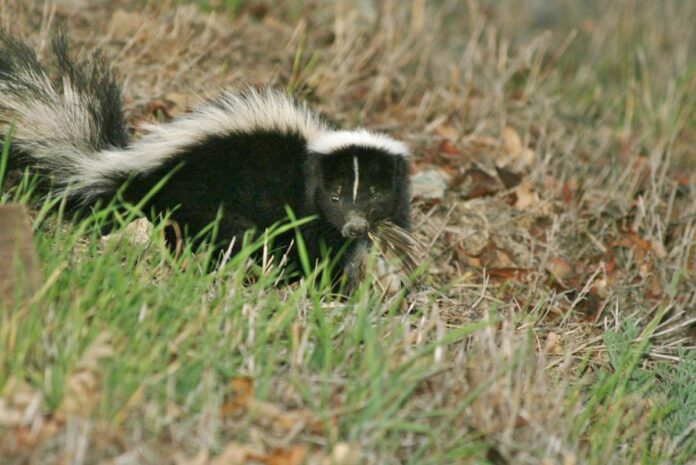Skunks can be found in a wide variety of habitats and ecosystems throughout the state of Virginia, but as nocturnal and generally solitary creatures they don’t often come into contact with humans intentionally. The odds of a close encounter do increase during this time of year, though.
Most skunks in the Eastern United States mate between January and mid-March. Like other mammals that typically live alone during their adult lives, skunks move between habitats and travel outside of their normal territories to find other members of their species with which to mate.
Additionally, skunks are polygamous; males mate with more than one female during the mating season and may travel several miles in search of females each night. As skunks are ramping up their activity levels, crossing roadways, exploring areas outside of their established territories, and potentially coming into contact with humans more often, keep these simple tips in mind:
- Slow down while driving and watch out for skunks crossing roads, especially at night and during twilight hours. As omnivores, skunks regularly consume plants, animals, and even carrion. Food litter left behind by humans near roadways is an easy meal for a skunk, but can often result in the animal being hit by a vehicle. Remember, no litter is safe litter!
-

Baby skunks (called kits) are usually born in May or June. Prepare your outdoor space to safely deter mother skunks from denning near your home. Following a gestation period of 60 to 75 days, baby skunks (called kits) are usually born in May or June and spend the first eight weeks of their lives in the safety of an underground burrow. Now is the time to check for existing or possible den sites beneath porches, crawlspaces, and other residential structures. The openings to skunk dens are usually about four to six inches wide and smell faintly like skunk. In general, skunks are not difficult to deter, and even mild harassment can make them leave the area, though it’s important to first identify if the skunk is a mother with babies. Visit the Center’s Skunks as Neighbors page for more information on how to safely prevent skunks from becoming long-term residents near your home.
- Learn to recognize defensive behavior in skunks in the event of an unplanned encounter. Skunks have poor eyesight and can be approached slowly, though it’s always important to watch for signs of agitation. Before spraying, an agitated skunk will first stamp its feet, turn around (with backend toward the target), raise its tail, and look over its shoulder and hiss. If the perceived threat does not leave, a skunk can spray up to five or six times and easily reach targets that are 15 feet away.
- Use extreme caution when interacting with skunks, especially when close contact is necessary. In Virginia, skunks are a species considered to be at high risk for rabies and roundworm. Visit the Center’s Sick and Injured Wildlife page to learn more about how to safely assist injured skunks.
By following these tips and sharing them with friends and family, we can all lend a hand to keep skunks and other wildlife safe. Happy Valentine’s Day!
For more information about the Center and its work, and to provide a donation of your own, visit https://www.wildlifecenter.org/.

